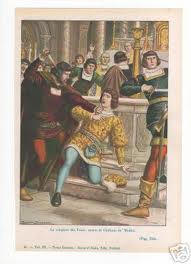Francesco de' Pazzi | |
|---|---|
 Francesco de' Pazzi (left) stabbing Giuliano de' Medici to death during the Pazzi conspiracy | |
| Coat of arms |  |
| Born | 28 January 1444 Florence, Republic of Florence |
| Died | 26 April 1478 (aged 34) Florence, Republic of Florence |
| Cause of death | Death by hanging |
| Noble family | Pazzi |
| Occupation | Banker |
Francesco de' Pazzi (28 January 1444 – 26 April 1478) was a Florentine banker, a member of the Pazzi noble family, and one of the instigators of the Pazzi conspiracy, a plot to displace the Medici family as rulers of the Florentine Republic. His uncle, Jacopo de' Pazzi, was one of the main organizers of the conspiracy.[1]
On 26 April 1478, Easter Sunday, there was an attempt to assassinate Lorenzo de' Medici and his brother and co-ruler Giuliano while both were attending High Mass at the Santa Maria del Fiore cathedral in Florence. Giuliano was murdered by Francesco and Bernardo Baroncelli, who inflicted a fatal sword wound to the head before stabbing him 19 times; however, Lorenzo survived the attack, having been merely wounded by the other conspirators.[2][3] Francesco then returned to his uncle's villa, where the latter found him with a wound in one leg, reportedly self-inflicted during the attack.[4]
Shortly after the failure of the Pazzi conspiracy, most of the people involved were hunted down and killed. Francesco was taken from his bed and dragged through the streets of Florence by an angry mob before ultimately being hanged from the Palazzo della Signoria, next to the decomposing body of fellow conspirator Francesco Salviati. His uncle Jacopo would soon meet the same fate.[5]
- ^ Jensen, De Lamar (1992). Renaissance Europe: Age of Recovery and Reconciliation (2nd ed.). Lexington, Massachusetts: D. C. Heath and Company. p. 80. doi:10.2307/3167078. ISBN 9780669200072. JSTOR 3167078. OCLC 25171924.
- ^ Smedley, Edward; James, Hugh James; Rose, Henry John (1845). Encyclopaedia Metropolitana; Or, Universal Dictionary of Knowledge on an Original Plan Comprising the Twofold Advantage of a Philosophical and an Alphabetical Arrangement, with Appropriate Engravings. B. Fellowes. p. 272.
- ^ Koestler-Grack, Rachel A. (1974). Joseph, Michael (ed.). Leonardo Da Vinci: Artist, Inventor, and Renaissance Man. Infobase Publishing. p. 152. ISBN 978-0791086261.
- ^ Kohl, Witt & Welles 1978, p. 315.
- ^ Hibbert, Christopher (6 December 2001) [1 January 1974]. The Rise and Fall of the House of Medici. Harmondsworth, Middlesex: Penguin UK. p. 141. ISBN 0140050906.